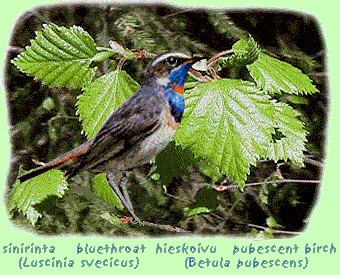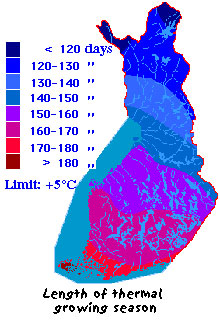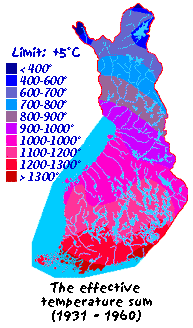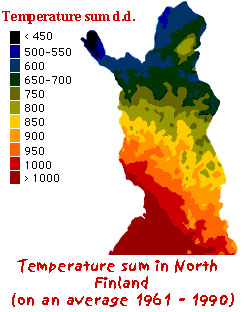
See also: Ecology!

Summer time
(the beginning)
The light period of the North is known for its long summer day and short winter day. At the beginning of May, the sun is above the horizon approximately 17 hours in Oulu and 19 hours in Utsjoki. In Utsjoki, the sun will stay above the horizon over two months, from May 17th to July 26th. Even in Sodankylä, the sun stays above the horizon from the end of May till round July 10th, i.e. over a month. More about the light period!
In general, the meteorologists do not read time signals from the sun but from temperatures. When the average temperature of a day exceeds (permanently) +10 Celsius degrees, it is the start of a thermal summer. It will end when the temperature falls (permanently) below +10 Celsius degrees in the autumn. A summer measured this way lasts, for instance, in Kajaani, from the beginning of June till the beginning of September (approximately three months), and in Inari, from the end of June till round August 20th (approximately two months). In the most southwest Finland, the summer lasts approximately four months.
The length of the growing season is determined by using slightly different limiting values than the limiting values of summer that were described before. The growing season begins (according to the definition used in Finland) when the average temperature of a day exceeds +5 Celsius degrees, and correspondingly, it ends in the autumn when the average temperature falls below +5 Celsius degrees. This kind of definition of the length of the growing season is used above all in agriculture but it gives an overall picture of reactions of everything else in nature (including phenology) towards temperature. However, not all growth in nature is tied to the temperature of +5 Celsius degrees. Many lichen, for instance, grow even in lower temperatures and stay in dormancy during the midsummer when it is too dry and hot for them. In addition, some seed plants (compare to e.g. spring flowers!) open their buds and flower in average temperatures that are below +5 Celsius degrees. The map shows that the length of the growing season in the northern parts of Lapland is only about three months long whereas in the most southern Finland it is of the length of six months.
 The effective temperature sum on the other hand tells how much warmth accumulates in
The effective temperature sum on the other hand tells how much warmth accumulates in all in a specific place/area during the summer.
all in a specific place/area during the summer.
The average temperature (+5 Celsius) of a day is set as a limiting value also in this. Therefore, if the average temperature of yesterday was +21 Celsius, the effective temperature sum accumulates in the following way: 21-5=16 Celsius degrees (limiting value being +5). And, if the average temperature of today is +15 Celsius, the effective temperature sum that accumulates is 15-5=10 Celsius degrees. Thus, yesterday and today together: 10+16=26 Celsius degrees.
As the map shows, approximately 500 degrees of effective temperature sum accumulates in Lapland during the summer. The number is nearly three times bigger in the most southern Finland.
The temperature sums shown in the map are measured in the meteorological stations that are situated two metres above the ground. It should be noted that during the summer, warmth accumulates in a different way on earth’s surface than in the canopy.
 In the map (left), the temperature sums of a summer have been counted by using the relative differences in altitude of the terrain, along with the information from the meteorological stations that are few in number. The fact is that the temperature falls when one reaches higher areas: it is warmer on the valleys (e.g. along the rivers) than in higher areas (e.g. fjelds). In Finland, this difference is about 0.8 Celsius per every 100 metres of difference in altitude.
In the map (left), the temperature sums of a summer have been counted by using the relative differences in altitude of the terrain, along with the information from the meteorological stations that are few in number. The fact is that the temperature falls when one reaches higher areas: it is warmer on the valleys (e.g. along the rivers) than in higher areas (e.g. fjelds). In Finland, this difference is about 0.8 Celsius per every 100 metres of difference in altitude.
The temperature sum accumulates differently in each year: sometimes quickly, sometimes slowly. The summers, for instance, in Sodankylä, may often be as cold as in Utsjoki and sometimes very warm – as warm as in the southern Finland!
In the north, the arriving of the summer takes time… It is often past the Midsummer before the weather is truly summery. Even the swarms of mosquitoes do not arrive until at the end of June. Therefore, the real June should be July! But, in the northern parts of Lapland, the average temperature of July is +10 Celsius – the same cool that is everywhere in the north near the timberline.
Days of hot spells (temperature over +25 Celsius) are rather few in the north but not altogether unknown. Frosty nights (frost on the level of the ground during the growing season) on the other hand are rather common especially in Lapland as early as in August. They are possible also in the spring – before the Midsummer. At that time, they are rather disastrous to wild plants whose growth is at its best and whose cell tissues are the most tender. Professor M. J. Kotilainen used the term so-called ‘Limes frigoris vernalis’ (= the line of spring frosts). He located this line round the borders of Pohjanmaa (Ostrobothnia) and Peräpohjola (Southern Lapland). Among other things many pteridophytes and orchids are sensitive to frost and unable to spread to Lapland due to spring frosts.
After a relatively dry spring and early summer, the rainfall starts to grow slowly towards autumn. However, the soil has got moisture from melting snow during the spring so usually there is no real dry season in the north. Although the rainfall remains smaller in the north than in the south, it is enough to maintain the moisture of the soil in cool climate.
Some examples of the correlations between the temperature sum and the phenology of plants:
1) The growth of the pine in timberline

In Kevo of Utsjoki – and everywhere else
in the north on the limits of the tolerance of pine –
the dependence of growth from the temperature sum can be seen very clearly.
In the south, this is not as clear; the temperature sum
does not become such a minimum factor, which it is on the northern line of pine.
Particularly very cold summers affect the growth. The summer of 1968 was very cold in Utsjoki (only 387 Celsius of temperature sum accumulated when the accumulation in the coniferous forest line is normally approximately 600 Celsius). The growth in length of the sprouts depends largely on the temperature conditions of the previous summer in the north; will the photosynthesis produce enough energy needed for growth to be put in store? The growth in height of the sprouts was minimal in the summer of 1969; there was no stored energy. The summer of 1970 on the other hand was quite warm; the accumulation of the temperature sum was greater than normally i.e. 823 Celsius. The growth in height in the summer 1971 was good (in the situation showed in the picture the growth in height had not yet stopped).
The growth in length of the needles seems to depend above all on the conditions of the summer in question (not the previous one). Thus, the needles were short in cold summer (1968) but long in warm summer 1970.
2) The time of blooming of the dwarfshrubs of the forest
The dependence of the time of flowering of blueberry and lingonberry from the temperature sum
of the twig level is examined in the picture. The correlation is clear: in the cold summer of 1985 both blueberry and lingonberry
flowered a couple of weeks later than in the warm summer of 1984. Nevertheless, the flowering took place
in approximately the same temperature sum in both summers (blueberry flowered when the temperature sum
had accumulated about 100 Celsius in the twig level, lingonberry on the other hand flowered
when the temperature sum had accumulated about 250 Celsius.
Quite undoubtedly also the temperature of the soil and its slow rise towards late summer affect the growth,
even though it is not visible when comparing these two years.
A known forest researcher professor Risto Sarvas pointed out in his time that among other things the time for the blossoming of trees is largely dependent on the accumulation of the temperature sum of the summer in question: in a cold summer the blossoming is delayed but in a warm summer the trees are in blossom even a week or two earlier. But they will always blossom when there is a certain amount of accumulation of the temperature sum – whether the early summer is cold or not. Different species of plants “demand” their “own temperature sum” before they flower. Plants have a so-called inner clock, which receives time signals among other things from the temperature sum (or from some other corresponding temperature “indicator”). Thus, the clock gives signals to plants when it is time to flower (or to start some other phase in their lives: coming into leaf, ripening of seeds or preparing for the winter probably depend on this clock system).
More examples of the relations between temperature and the growth of plants can be found among other things in the chapter 'The diverse climate'.